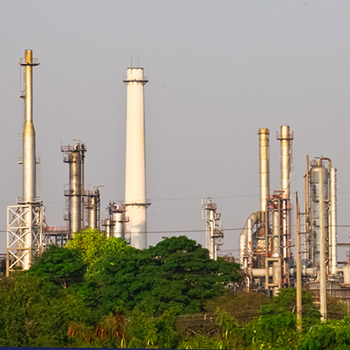 Industrial Access, Inc., was contracted to perform rigging and lifting services after a decommissioned stack collapsed at a major industrial facility in the United States. The steel structure was not in use at the time, but it was not properly retired from service, before it fell. This preventable incident caused millions in damages and forced the plant into an unplanned outage lasting over two months.
Industrial Access, Inc., was contracted to perform rigging and lifting services after a decommissioned stack collapsed at a major industrial facility in the United States. The steel structure was not in use at the time, but it was not properly retired from service, before it fell. This preventable incident caused millions in damages and forced the plant into an unplanned outage lasting over two months.
Stack Description
The insulated, single walled, carbon steel stack approx. 100’ tall, 10’ diameter, sat on top of a building at the facility, connected to a breeching duct. The stack was anchored into the structural steel in the roofline of the building. On the interior surface of the stack, slightly below the breaching duct, a false floor was installed to separate the base of the stack from the roofline.
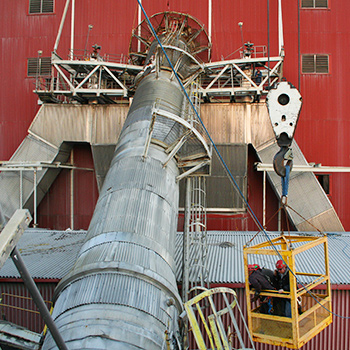
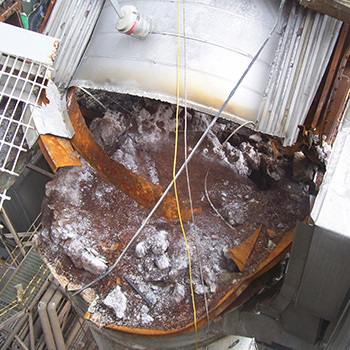 Cause of Failure
Cause of Failure
When the client decided to no longer use the stack, the structure was not decommissioned properly. Invisible process gas contaminants, over time built up on the interior surface of the stack. When sulfur-bearing fuel is burned, sulfur is converted to sulfur dioxide (SO2) and sulfur trioxide (SO3). The sulfur trioxide combines with moisture to form sulfuric acid (H2SO4). During combustion, some nitrogen is oxidized to form nitrogen dioxide (NO2). Nitrogen dioxide in the flue also reacts with water to give nitric acid and with sulfur dioxide and water to form more sulfuric acid. This acid was allowed to build up at the base of the stack, due to a malfunctioning drain.
As a result of the standing acid water, the stack began to develop a 360° ring of corrosion. The thinning steel then became structurally deficient and failed at its weakest point during a high wind event. This could have been prevented, if the stack was taken out of service properly.
When a stack is decommissioned, the interior surface should be washed down with an acid neutralizing solvent, then a cap should be installed to prevent excess water build-up in the base. A drain should be installed at the base and checked on a yearly basis to ensure proper drainage. Internal coatings can be applied as an additional level of protection.
Emergency Response
Due to location and reach required to access the fallen stack this project required one of the largest cranes on the continent to complete the scope of work. Industrial Access Inc., (IA) and the crane vendor, mobilized to the site on short notice to begin the process of assessing the damage and removing the fallen structure from the powerhouse. Because this accident caused an unplanned outage, contractors understood the importance of completing this project both quickly and safely as possible.
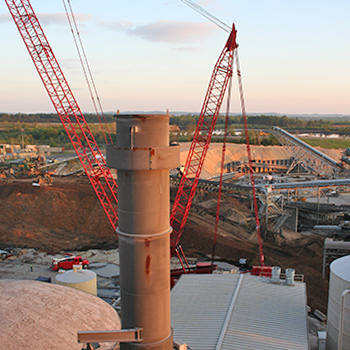
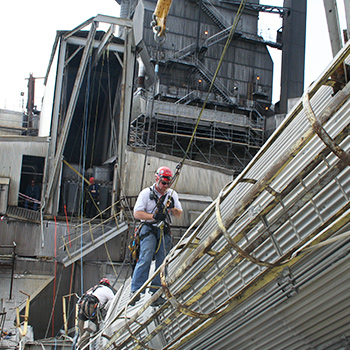
Approach
Before any lifting could begin, IA completed a pre-inspection of the structure. This pre-inspection determined the overall approach to lifting and removing the structure. After the pre-inspection was completed, IA then began removing any loose insulation or steel that could become a falling hazard during the lift. This was completed by utilizing a combination of crane lifts and rope access techniques.
IA’s engineering department calculated the sizes of windows to be cut into the structure and designed the rigging system utilized to lift the stack.
Lift & Project Completion
After all falling hazards were removed and the fallen stack was deemed structurally sound to lift by IA structural engineers, the stack was lifted in a single pick and was removed from the building and laid down successfully.
Due to Industrial Access’s quick response and multiple in-house services, this project was completed under budget and on schedule.
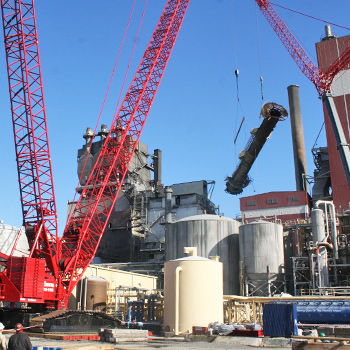
For additional information about our company and services we provide, please give is a call anytime at (770)-255-1313.



